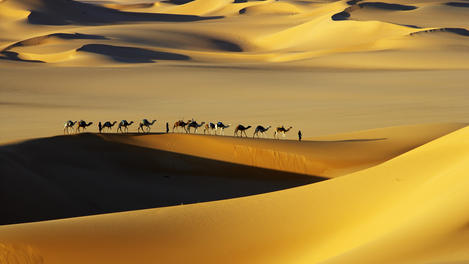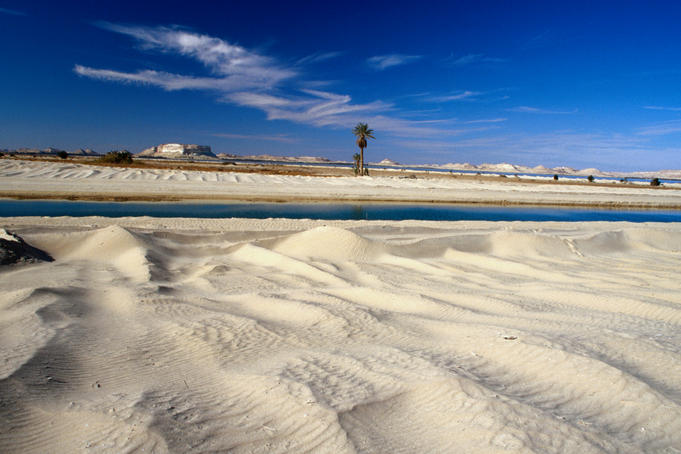 A fount of solitude and the desert of childhood imaginings, the Sahara Desert is like nowhere else on earth. It is the world’s largest desert, at once continental in its scale and exquisite in its detail, from a sand sea the size of a small European country to an orange sand dune sculpted to perfection by the wind. Covering a territory roughly equivalent to the United States, the Sahara crosses around 20 lines of longitude and encompasses at least ten countries – Morocco, Mauritania, Mali, Algeria, Libya, Niger, Tunisia, Chad, Egypt and Sudan – and the disputed territory of Western Sahara.
A fount of solitude and the desert of childhood imaginings, the Sahara Desert is like nowhere else on earth. It is the world’s largest desert, at once continental in its scale and exquisite in its detail, from a sand sea the size of a small European country to an orange sand dune sculpted to perfection by the wind. Covering a territory roughly equivalent to the United States, the Sahara crosses around 20 lines of longitude and encompasses at least ten countries – Morocco, Mauritania, Mali, Algeria, Libya, Niger, Tunisia, Chad, Egypt and Sudan – and the disputed territory of Western Sahara.Parts of the Sahara are currently off-limits to travellers, but such is its scale that significant areas can still be visited, most notably in Morocco, Tunisia and Egypt. In these places, experiencing the Sahara is all about remote campfires, slow, soulful camel journeys and more wide-ranging 4WD expeditions.
Saharan travel
A journey into the Sahara can be as varied as the desert itself, but there are some quintessential Saharan experiences. Most begin in the gateway towns where expeditions out into the desert are organised. Often oases, these towns are centres of Saharan culture, places where the architecture emerges naturally from the earth and the slow pace of life has changed little in centuries.
For exploring beyond town or village limits, there are two major means of getting around. A slow march across the sands astride a camel re-enacts the great camel caravans of Saharan lore – on a camel safari, travellers slow down to a pace well suited to the Sahara’s unforgiving climate, allowing you to appreciate details and pass through this spectacular terrain at one with your surroundings. In a 4WD expedition, travellers can range further, stirring up the sand as you tick off a list of iconic Saharan landscapes.
Sleeping between four walls is an experience that ends in the towns. Out amid the sands or remote Saharan mountains, evenings are spent around a campfire and a soft bed of sand is the night-time mattress of choice. Most Saharan excursions carry tents but many travellers prefer to sleep outdoors beneath the clearest show of stars on earth.
When to go
Travel in the Sahara is best between October and April or early May when daytime temperatures are generally bearable. In the depths of the Saharan winter (especially December and January), night-time temperatures can fall below freezing. Sand storms are possible from January through May, while no sensible person ventures into the fierce firestorm of heat that blankets the Sahara from June to early September. Rain is rarely a problem.
Safe Sahara
The following Saharan countries are currently open to travellers and are good options for first time Saharan travel.
Morocco
Southeastern Morocco, in the lee of the snow-capped High Atlas Mountains, is the most accessible slice of the Sahara. It was in the Drâa Valley – a picturesque world of expansive palm groves, earth-red kasbahs and Berber hamlets – that trans-Saharan camel caravans began and ended their 52-day journey across the Sahara to Timbuktu. These days, shorter camel excursions head out from M’Hamid into the Erg Chigaga, a stunning 40km-long ribbon of extraordinary sand dunes. Further east, from the tiny village of Merzouga, camel forays and 4WD trips lead out into Erg Chebbi, a glorious collection of seemingly eternal dunes. Both Merzouga and M’Hamid are a one-day bus journey from Marrakesh.
Tunisia
Tunisia’s south cuts a deep wedge into the northern Sahara, carving out what could just be the Sahara’s most celebrated corner. It was here that film directors found sufficient cinematic beauty to provide a backdrop for the Star Wars series and the English Patient. The two main gateway towns are Tozeur, a seven-hour bus ride or one-hour flight from Tunis, and Douz, a nine-hour bus ride from Tunisia’s capital. The former sits close to the immense salt lake of Chott el-Jerid and some of the most evocative sites of Star Wars filming; the latter is the last stop before the soul-stirring sand summits of the Grand Erg Oriental, one of the world’s largest seas of sand that spills over into Algeria. For true Saharan immersion, the remote outpost of Ksar Ghilane, 147km south of Douz, has an abandoned fortress and the Tunisian Sahara’s most splendid scenery.
Egypt
The west of Egypt is a vast yet beguiling corner of the Sahara. A string of oases, connected by barely discernible tracks across the sand, begins in the north at Siwa, home to a crumbling medieval mud fortress and a temple that dates back to the time of Alexander the Great. Away to the south, the oases of Al-Kharga, Dakhla, Farafra and Bahariya provide focal points for expeditions into the void, while beyond the last outpost of human habitation lie places of Saharan longing, including the White Desert, the Black Desert and the Crystal Mountain. More remote even than these, the Gilf Kebir Plateau is the reputed home of the never-found Zerzura Oasis, and the undisputed location of the Cave of Swimmers, made famous on the silver screen by the English Patient. All of the oases have direct bus services to/from Cairo that will take at least a day to complete. Al-Kharga also has a much faster air connection with Egypt’s capital. Once in the oases, 4WD are much more common than camel excursions.
Forbidden Sahara
The Sahara’s most beautiful landscapes lie – perhaps not surprisingly – deep in the desert’s heart. Sadly, at present, most of these countries remain off-limits to travellers due to political conflict and instability.
Within these areas, Algeria has sand seas that boast some of the largest sand dunes on earth, and the rocky landscape of the country’s southeast – the Ahaggar and Tassili mountain ranges in particular – produces some of the Sahara’s most otherworldly scenery. The ancient rock art of the latter makes it a Unesco World Heritage Site. Just across the border, Libya’s Jebel Acacus is similarly beautiful, while its vast sand seas, isolated black-sand volcanoes and postcard-perfect lakes rank high among the Sahara’s most beautiful corners. Elsewhere, the Tibesti Mountains of northern Chad, Niger’s Aïr Massif and Ténéré sands, Mauritania’s ancient cities and verdant oases, and Mali’s Timbuktu round out an elite portfolio of Saharan attractions.
For current travel advice on these destinations, government travel warnings are one source of information. Another is the excellent Sahara Overland forum for independent-minded travellers at www.sahara-overland.com.



